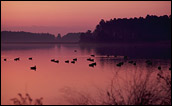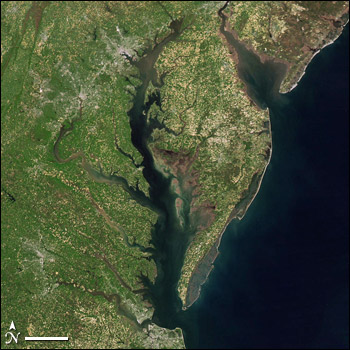

 | If the Chesapeake Bay were a high school student, it might be afraid to show its parents its report card. For the past seven years, the environmental monitoring group the Chesapeake Bay Foundation has rated the health of the Chesapeake Bay ecosystem a paltry 27-28 on a scale of 100. The 2004 “State of the Bay” report revealed widespread pollution with nitrogen, phosphorus, mercury, and sediment. Underwater grasses—the nurseries of Maryland’s famous blue crabs—followed a dramatic crash in 2003 with another small decline in 2004. The rate of development targeting wetlands, forest buffers, and other natural landscapes shows no sign of slowing down. The status of the rockfish population earned the Bay’s fisheries only A; blue crabs earned a C; oysters and shad each received an F. |

Although the Chesapeake Bay appears serene at the water’s surface, changes in the surrounding landscape threaten the complex ecosystem. (Photograph courtesy USDA Agricultural Research Service) |
|
 |
The blue crab is one of many aquatic species in the Chesapeake Bay that is threatened by poor water quality. NASA research is revealing how rainfall in the surrounding watershed affects the health of the Chesapeake and its inhabitants. (Photograph courtesy United States Food and Drug Administration) | ||
Multi-billion-dollar federal restoration efforts are underway, and watershed states Pennsylvania, Maryland, Virginia, and District of Columbia signed an agreement in 2000 that committed each state to doing its part to get the Chesapeake Bay off the Environmental Protection Agency’s list of impaired U.S. waters by 2010. One of the main targets of restoration is the reduction of nitrogen from aging and over-capacity wastewater (sewage) treatment plants and stormwater runoff. Nitrogen flowing to the Bay from rivers and streams fertilizes algae and other single-celled plants in the Bay, and they bloom explosively. When the plants die, they are decomposed by bacteria. Bacterial activity can use up all (or nearly all) of the oxygen dissolved in bottom waters, creating conditions where other aquatic life can’t survive. In 2004, ocean and remote-sensing scientist James Acker generated some evidence supporting the idea that reducing the flow of nitrogen into the Bay would improve Bay health. A Chesapeake-watershed resident, Acker works at NASA’s Goddard Earth Sciences Data and Information Services Center (GES DISC) in Greenbelt, Maryland. In 2004, Acker was seeking a research project he could use to test-drive an online, data analysis program recently developed by scientists and technical staff at NASA. The program had been designed for rapid analysis of satellite observations of ocean color, the visible light that penetrates water surfaces and reflects off what is floating or dissolved there. | |||

Acker was looking for a project he could use to demonstrate to scientists and natural resource managers how easy the new data tool was to use, and how quickly it could give them information about biological processes in a particular body of water. Ocean color depends on what is in the water. When large numbers of plants are growing in the water, the chlorophyll and other plant pigments affect the water’s color, making it greener, sometimes even with shades of red. Acker decided to compare satellite-based chlorophyll observations of the Chesapeake Bay from the previous two years. “In 2002,” Acker explained, “the entire mid-Atlantic region was gripped by a severe drought. When the drought relented, 2003 then became one of the rainiest years in [recorded] history.” The contrasting rainfall and runoff patterns were bound to influence Bay biology, he reasoned. Acker expected that the changes in the Chesapeake Bay environment due to the 2002 drought and the 2003 deluge would create differences in satellite ocean color observations. He didn’t expect, however, that his quick proof-of-concept demonstration project would provide convincing evidence that one of the main goals for improving the health of the Bay—reducing the input of nitrogen from streams and rivers—was right on target. |
Researchers use satellite measurements of ocean color to estimate the amount of microscopic plant life that lives in the Chesapeake Bay and other bodies of water. The kinds and amounts of plant life are indicators of the health of marine ecosystems. (NASA image courtesy Jeff Schmaltz, MODIS Rapid Response) | ||